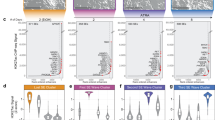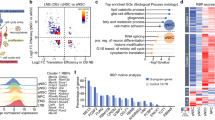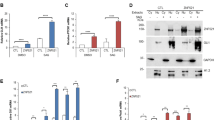Abstract
Transforming growth fazctor-β (TGFβ) family members regulate many developmental and pathological events through Smad transcriptional modulators. How nuclear accumulation of Smad is coupled to the transcriptional machinery is poorly understood. Here we demonstrate that in response to TGFβ stimulation the transcriptional regulator TAZ binds heteromeric Smad2/3–4 complexes and is recruited to TGFβ response elements. In human embryonic stem cells TAZ is required to maintain self-renewal markers and loss of TAZ leads to inhibition of TGFβ signalling and differentiation into a neuroectoderm lineage. In the absence of TAZ, Smad2/3–4 complexes fail to accumulate in the nucleus and activate transcription. Furthermore, TAZ, which itself engages in shuttling, dominantly controls Smad nucleocytoplasmic localization and can be retained in the nucleus by transcriptional co-factors such as ARC105, a component of the Mediator complex. TAZ thus defines a hierarchical system regulating Smad nuclear accumulation and coupling to the transcriptional machinery.
This is a preview of subscription content, access via your institution
Access options
Subscribe to this journal
Receive 12 print issues and online access
$209.00 per year
only $17.42 per issue
Buy this article
- Purchase on Springer Link
- Instant access to full article PDF
Prices may be subject to local taxes which are calculated during checkout








Similar content being viewed by others
References
Siegel, P.M. & Massague, J. Cytostatic and apoptotic actions of TGFβ in homeostasis and cancer. Nature Rev. Cancer 3, 807–821 (2003).
Feng, X.H. & Derynck, R. Specificity and versatility in TGFβ signaling through Smads. Annu. Rev. Cell Dev. Biol. 21, 659–693 (2005).
Attisano, L. & Wrana, J.L. Signal transduction by the TGFβ superfamily. Science 296, 1646–1647 (2002).
Ying, Q.L., Nichols, J., Chambers, I. & Smith, A. BMP induction of Id proteins suppresses differentiation and sustains embryonic stem cell self-renewal in collaboration with STAT3. Cell 115, 281–292 (2003).
James, D., Levine, A.J., Besser, D. & Hemmati-Brivanlou, A. TGFβ/activin/nodal signaling is necessary for the maintenance of pluripotency in human embryonic stem cells. Development 132, 1273–1282 (2005).
Vallier, L., Alexander, M. & Pedersen, R.A. Activin/Nodal and FGF pathways cooperate to maintain pluripotency of human embryonic stem cells. J. Cell Sci. 118, 4495–4509 (2005).
Kurisaki, A., Kose, S., Yoneda, Y., Heldin, C.H. & Moustakas, A. Transforming growth factor-β induces nuclear import of Smad3 in an importin-β1 and Ran-dependent manner. Mol. Biol. Cell 12, 1079–1091 (2001).
Xiao, Z., Liu, X., Henis, Y.I. & Lodish, H.F. A distinct nuclear localization signal in the N terminus of Smad 3 determines its ligand-induced nuclear translocation. Proc. Natl Acad. Sci. USA 97, 7853–7858 (2000).
Xu, L. et al. Msk is required for nuclear import of TGFβ/BMP-activated Smads. J. Cell Biol. 178, 981–994 (2007).
Kurisaki, A. et al. The mechanism of nuclear export of Smad3 involves exportin 4 and Ran. Mol. Cell Biol. 26, 1318–1332 (2006).
Xu, L., Alarcon, C., Col, S. & Massague, J. Distinct domain utilization by Smad3 and Smad4 for nucleoporin interaction and nuclear import. J. Biol. Chem. 278, 42569–42577 (2003).
Xu, L., Kang, Y., Col, S. & Massague, J. Smad2 nucleocytoplasmic shuttling by nucleoporins CAN/Nup214 and Nup153 feeds TGFβ signaling complexes in the cytoplasm and nucleus. Mol. Cell 10, 271–282 (2002).
Inman, G.J., Nicolas, F.J. & Hill, C.S. Nucleocytoplasmic shuttling of Smads 2, 3, and 4 permits sensing of TGFβ receptor activity. Mol. Cell 10, 283–294 (2002).
Watanabe, M., Masuyama, N., Fukuda, M. & Nishida, E. Regulation of intracellular dynamics of Smad4 by its leucine-rich nuclear export signal. EMBO Rep. 1, 176–182 (2000).
Hoodless, P.A. et al. Dominant-negative Smad2 mutants inhibit activin/Vg1 signaling and disrupt axis formation in Xenopus. Dev. Biol. 207, 364–379 (1999).
Liu, F., Pouponnot, C. & Massague, J. Dual role of the Smad4/DPC4 tumor suppressor in TGFβ-inducible transcriptional complexes. Genes Dev. 11, 3157–3167 (1997).
Nicolas, F.J., De Bosscher, K., Schmierer, B. & Hill, C.S. Analysis of Smad nucleocytoplasmic shuttling in living cells. J. Cell Sci. 117, 4113–4125 (2004).
Schmierer, B. & Hill, C.S. Kinetic analysis of Smad nucleocytoplasmic shuttling reveals a mechanism for transforming growth factor β-dependent nuclear accumulation of Smads. Mol. Cell Biol. 25, 9845–9858 (2005).
Macias-Silva, M. et al. MADR2 is a substrate of the TGFβ receptor and its phosphorylation is required for nuclear accumulation and signaling. Cell 87, 1215–1224 (1996).
Nakao, A. et al. TGFβ receptor-mediated signalling through Smad2, Smad3 and Smad4. EMBO J. 16, 5353–5362 (1997).
Barrios-Rodiles, M. et al. High-throughput mapping of a dynamic signaling network in mammalian cells. Science 307, 1621–1625 (2005).
Hong, J.H. & Yaffe, M.B. TAZ: a β-catenin-like molecule that regulates mesenchymal stem cell differentiation. Cell Cycle 5, 176–179 (2006).
Hong, J.H. et al. TAZ, a transcriptional modulator of mesenchymal stem cell differentiation. Science 309, 1074–1078 (2005).
Kowanetz, M., Valcourt, U., Bergstrom, R., Heldin, C.H. & Moustakas, A. Id2 and Id3 define the potency of cell proliferation and differentiation responses to transforming growth factor β and bone morphogenetic protein. Mol. Cell Biol. 24, 4241–4254 (2004).
Nakao, A. et al. Identification of Smad7, a TGFβ-inducible antagonist of TGFβ signalling. Nature 389, 631–635 (1997).
Westerhausen, D.R., Jr., Hopkins, W.E. & Billadello, J.J. Multiple transforming growth factor-β-inducible elements regulate expression of the plasminogen activator inhibitor type-1 gene in Hep G2 cells. J. Biol. Chem. 266, 1092–1100 (1991).
Cui, C.B., Cooper, L.F., Yang, X., Karsenty, G. & Aukhil, I. Transcriptional coactivation of bone-specific transcription factor Cbfa1 by TAZ. Mol. Cell Biol. 23, 1004–1013 (2003).
Nagarajan, R.P., Zhang, J., Li, W. & Chen, Y. Regulation of Smad7 promoter by direct association with Smad3 and Smad4. J. Biol. Chem. 274, 33412–33418 (1999).
Sirard, C. et al. Targeted disruption in murine cells reveals variable requirement for Smad4 in transforming growth factor β-related signaling. J. Biol. Chem. 275, 2063–2070 (2000).
von Both, I. et al. Foxh1 is essential for development of the anterior heart field. Dev. Cell 7, 331–345 (2004).
Waldrip, W.R., Bikoff, E.K., Hoodless, P.A., Wrana, J.L. & Robertson, E.J. Smad2 signaling in extraembryonic tissues determines anterior-posterior polarity of the early mouse embryo. Cell 92, 797–808 (1998).
Izzi, L. et al. Foxh1 recruits Gsc to negatively regulate Mixl1 expression during early mouse development. EMBO J. (2007).
Keller, G. Embryonic stem cell differentiation: emergence of a new era in biology and medicine. Genes Dev. 19, 1129–1155 (2005).
Peerani, R. et al. Niche-mediated control of human embryonic stem cell self-renewal and differentiation. EMBO J. 26, 4744–4755 (2007).
Smith, J.R. et al. Inhibition of Activin/Nodal signaling promotes specification of human embryonic stem cells into neuroectoderm. Dev. Biol. 313, 107–117 (2008).
Souchelnytskyi, S. et al. Phosphorylation of Ser 465 and Ser 467 in the C terminus of Smad2 mediates interaction with Smad4 and is required for transforming growth factor-β signaling. J. Biol. Chem. 272, 28107–28115 (1997).
Abdollah, S. et al. TβRI phosphorylation of Smad2 on Ser 465 and Ser 467 is required for Smad2-Smad4 complex formation and signaling. J. Biol. Chem. 272, 27678–27685 (1997).
Murakami, M. et al. Transcriptional activity of Pax3 is co-activated by TAZ. Biochem. Biophys. Res. Commun. 339, 533–539 (2006).
Kanai, F. et al. TAZ: a novel transcriptional co-activator regulated by interactions with 14-3-3 and PDZ domain proteins. EMBO J. 19, 6778–6791 (2000).
Kato, Y., Habas, R., Katsuyama, Y., Naar, A.M. & He, X. A component of the ARC/Mediator complex required for TGF-β/Nodal signalling. Nature 418, 641–646 (2002).
Myers, L.C. & Kornberg, R.D. Mediator of transcriptional regulation. Annu. Rev. Biochem. 69, 729–749 (2000).
Murakami, M., Nakagawa, M., Olson, E.N. & Nakagawa, O. A WW domain protein TAZ is a critical coactivator for TBX5, a transcription factor implicated in Holt-Oram syndrome. Proc. Natl Acad. Sci. USA 102, 18034–18039 (2005).
Schneider, R. et al. Histone H3 lysine 4 methylation patterns in higher eukaryotic genes. Nature Cell Biol. 6, 73–77 (2004).
Baker, J.C. & Harland, R.M. A novel mesoderm inducer, Madr2, functions in the activin signal transduction pathway. Genes Dev. 10, 1880–1889 (1996).
Cook, P.R. The organization of replication and transcription. Science 284, 1790–1795 (1999).
Lin, X. et al. PPM1A functions as a Smad phosphatase to terminate TGFβ signaling. Cell 125, 915–928 (2006).
Labbe, E., Silvestri, C., Hoodless, P.A., Wrana, J.L. & Attisano, L. Smad2 and Smad3 positively and negatively regulate TGFβ-dependent transcription through the forkhead DNA-binding protein FAST2. Mol. Cell 2, 109–120 (1998).
Acknowledgements
We would like to thank L. Attisano and R. Bremner for critical review and helpful discussions, A. Nagy for the CA1 hES cells and M. Barrios-Rodiles for expertise with LUMIER. This work was supported by funds from Genome Canada through the Ontario Genomics Institute and the Canadian Institutes of Health Research (J.W.L., CIHR Grant number MT 12860; P.W.Z., CIHR Grant number MOP-57885) and the National Cancer Institute of Canada with funds from the Canadian Cancer Society. X.V. is supported by a National Cancer Institute of Canada fellowship. J.L.W. is a CRC Chair and an International Scholar of the Howard Hughes Medical Institute.
Author information
Authors and Affiliations
Contributions
X.V. and J.L.W. designed and wrote the paper; X.V carried out most of the experiments; R.S. performed the mESC experiments; R.P. and B.M.R. performed the hESC knockdown experiments and cellomics analysis in P.W.Z.'s lab; P.S.T. carried out the knockdown experiments in NIH3T3 cells and helped with other experiments; J.D. carried out the initial follow-up to the LUMIER screen; M.B.Y. and P.W.Z. contributed reagents and discussion.
Corresponding author
Ethics declarations
Competing interests
The authors declare no competing financial interests.
Supplementary information
Supplementary Information
Supplementary Figures S1, S2, S3, S4, S5, S6 and Supplementary Table 1 (PDF 2301 kb)
Rights and permissions
About this article
Cite this article
Varelas, X., Sakuma, R., Samavarchi-Tehrani, P. et al. TAZ controls Smad nucleocytoplasmic shuttling and regulates human embryonic stem-cell self-renewal. Nat Cell Biol 10, 837–848 (2008). https://doi.org/10.1038/ncb1748
Received:
Accepted:
Published:
Issue Date:
DOI: https://doi.org/10.1038/ncb1748
This article is cited by
-
PDGFBB improved the biological function of menstrual blood-derived stromal cells and the anti-fibrotic properties of exosomes
Stem Cell Research & Therapy (2023)
-
USP1-regulated reciprocal differentiation of Th17 cells and Treg cells by deubiquitinating and stabilizing TAZ
Cellular & Molecular Immunology (2023)
-
Oncogenic signaling-mediated regulation of chromatin during tumorigenesis
Cancer and Metastasis Reviews (2023)
-
Role of the Hippo pathway in liver regeneration and repair: recent advances
Inflammation and Regeneration (2022)
-
Mechanical control of nuclear import by Importin-7 is regulated by its dominant cargo YAP
Nature Communications (2022)



